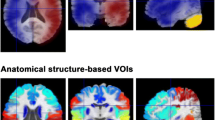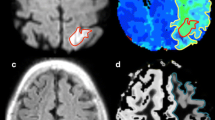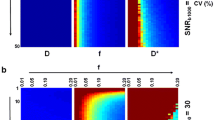Abstract
Inadequate blood supply relative to metabolic demand, a haemodynamic condition termed as misery perfusion, often occurs in conjunction with acute ischaemic stroke. Misery perfusion results in adaptive changes in cerebral physiology including increased cerebral blood volume (CBV) and oxygen extraction ratio (OER) to secure substrate supply for the brain. It has been suggested that the presence of misery perfusion may be an indication of reversible ischaemia, thus detection of this condition may have clinical impact in acute stroke imaging. The ability of single spin echo T2 to detect misery perfusion in the rat brain at 1.5 T owing to its sensitivity to blood oxygenation level dependent (BOLD) contrast was studied both theoretically and experimentally. Based on the known physiology of misery perfusion, tissue morphometry and blood relaxation data, T2 behaviour in misery perfusion was simulated. The interpretation of these computations was experimentally assessed by quantifying T2 in a rat model for cerebral misery perfusion. CBF was quantified with the H2 clearance method. A drop of CBF from 58 ± 8 to 17 ± 3 ml/100 g min in the parieto-frontal cortex caused shortening of T2. from 66.9 ± 0.4 to 64.6 ± 0.5 ms. Under these conditions, no change in diffusion MRI was detected. In contrast, the cortex with CBF of 42 ± 7 ml/100 g min showed no change in T2. Computer simulations accurately predicted these T2, responses. The present study shows that the acute drop of CBF by 70% causes a negative BOLD that is readily detectable by T2 MRI at 1.5 T. Thus BOLD may serve as an index of misery perfusion thus revealing viable tissue with increased OER.
Similar content being viewed by others

References
Brindle KM, Brown FF, Cambell ID. Grathwohl C, Kuchel PW. Applicationof spin-echo nuclear magnetic resonance to whole-cell systems. Biochem J 1979;180:37–44.
Thulborn KR, Waterton JC, Matthews PM, Radda GK. Oxygenation dependence of the transverse relaxation time of water protons in whole blood at high field. Biochim Biophys Acta 1982;714:265–70.
Ogawa S, Lee T-M. Magnetic resonance imaging of blood vessels at high fields: in vivo and in vitro measurements and image simulation. Magn Reson Med 1990:16:9–18.
Ogawa S. Lee T-M, Nayak AS, Glynn P. Oxygenation-sensitive contrast in magnetic resonance image of rodent brain at high magnetic fields. Magn Reson Med 1990;14:68–78.
Kwong KK, Belliveau JW, Chesler DA, Goldberg IE, Weisskoff RM, Poncelet BP, Kennedy DN, Hoppel BE, Cohen MS. Turner R, Cheng H-M, Brady TJ, Rosen BR. Dynamic magnetic resonance imaging of human brain activity during primary sensory stimulation. Proc Natl Acad Sci USA 1992;89:5675–9.
Ogawa S. Tank DW, Menon R, Ellermann JM, Kim SG, Merkle H, Ugurbil K. Intrinsic signal changes accompanying sensory stimulation: functional brain mapping with magnetic resonance imaging. Proc Natl Acad Sci USA 1992;89:5951–5.
Ogawa S, Menon RS, Tank DW, Kim S-G, Merkle H, Ellerman JM, Ugurbil K. Functional brain mapping by blood oxygenation level-dependent contrast magnetic resonance imaging: a comparison of signal characteristics with a biophysical model. Biophys J 1993:64:803–12.
van Zijl PC, Eleff SM, Ulatowski JA, Oja JM, Ulug AM, Traystman RJ, Kauppinen RA. Quantitative assessment of blood flow, blood volume and blood oxygenation effects in functional magnetic resonance imaging. Nat Med 1998;4:159–67.
Haughton VM, Turski PA, Meyerand B, Wendt G. Moritz CH, Ulmer J. The clinical applications of functional MR imaging. Neuroimaging Clin N Am 1999;9:285–93.
Detre JA. Sirven JI, Alsop DC, O’Connor MJ, French JA. Localization of subclinical ictal activity by functional magnetic resonance imaging: correlation with invasive monitoring. Ann Neurol 1995:38:618 24.
Turner R, Le Bihan D. Moonen CTW. Despres D. Frank J. Echo-planar time course MRI of cat brain oxygenation changes. Magn Reson Med 1991;22:159–66.
De Crespigny AJ, Wendland MF, Derugin N, Kozniewska E, Moseley ME. Real time observation of transient focal ischemia and hyperemia in cat brain. Magn Reson Med 1992;27:391 -7.
Gröhn OH, Lukkarinen JA, Oja JM, van Zijl PC, Ulatowski JA. Traystman RJ. Kauppinen RA. Noninvasive detection of cerebral hypoperfusion and reversible ischemia from reductions in the magnetic resonance imaging relaxation time. T2. J Cereb Blood Flow Metab 1998;18:911–20.
Calamante F. Lythgoe MF, Pell GS, Thomas DL. King MD. Busza AL. Sotak CH. Williams SR. Ordidge RJ. Gadian DG. Early changes in water diffusion, perfusion. T1, and T2 during focal cerebral ischemia in the rat studied at 8.5 T. Magn Reson Med 1999;41:479–85.
Gröhn OHJ. Kettunen MI, Penttonen M, Oja JME. van Zijl PCM, Kauppinen RA. Graded reduction of cerebral blood flow in rat as detected by the nuclear magnetic resonance relaxation time T2: A theoretical and experimental approach. J Cereb Blood Flow Metab 2000;20:316–26.
Powers WJ. Cerebral hemodynamics in ischemic eerebrovascular disease. Ann Neurol 1991;29:231–40.
Knight RA, Dereski MO, Helpern JA, Ordidge RJ. Chopp M. Magnetic resonance imaging assessment of evolving focal cerebral ischemia. Comparison with histopathology in rats. Stroke 1994;25:1252–61.
Baron JC. Bousser MG. Rey A, Guillard A, Comar D. Castaigne P. Reversalof focal “misery-perfusion syndrome” by extra-intracranial arterial bypass in hemodynamic cerebral ischemia. A case study with 15O positron emission tomography. Stroke 1981;12:454–9.
Wise RJ, Bernardi S, Frackowiak RS, Legg NJ, Jones T. Serial observations on the pathophysiology of acute stroke. The transition from ischaemia to infarction as reflected in regional oxygen extraction. Brain 1983;106:197–222.
Sorensen AG; Buonanno FS, Gonzalez RG, Schwamm LH, Lev MH, Huang-Hellinger FR. Reese TG, Weisskoff RM. Davis TL. Suwanwela N, Can U, Moreira JA, Copen WA, Look RB, Finklestein SP, Rosen BR, Koroshetz WJ. Hyperacute stroke: evaluation with combined multisection diffusion-weighted and hcmodynamic weighted echo-planar imaging. Radiology 1996; 199:391–401.
Grubb RL, Jr, Derdeyn CP, Fritsch SM, Carpenter DA. Yundt KD, Videen TO, Spitznagel EL. Powers WJ. Importance of hemodynamic factors in the prognosis of symptomatic carotid occlusion. JAMA 1998;280:1055–60.
Young AR, Sette G, Touzani O, Rioux P, Derlon JM, MacKenzie ET, Baron JC. Relationships between high oxygen extraction fraction in the acute stage and final infarction in reversible middle cerebral artery occlusion: an investigation in anesthetized baboons with positron emission tomography. J Cereb Blood Flow Metab 1996;16:1176–88.
Bandettini PA, Wong EC, Jesmanowicz A, Hinks RS, Hyde JS. Spin-echo and gradient-echo EPI of human brain activation using BOLD contcast: A comparative study at 1.5 T. NMR Biomed 1994;7:12–20.
Oja JME. In vivo determination of cerebral hemodynamics and bioenergetics using spin-echo magnetic resonance imaging. Kuopio: Kuopio University Publications. 1999.
Ulatowski JA, Oja JM. Suarez JI, Kauppinen RA, Traystman RJ, van Zijl PC. In vivo determination of absolute cerebral blood volume using hemoglobin as a natural contrast agent: an MRI study using altered arterial carbon dioxide tension. J Cereb Blood Flow Metab 1999;19:809–17.
Oja JME. Gillen JS, Kauppinen RA, Kraut M. van Zijl PCM. Determination of oxygen extraction ratios by magnetic resonance imaging. J Cereb Blood Flow Metab 1999;19:1289–95.
Golay X., Silvennoinen M.J., Zhou J., Kauppinen R.A., Pekar J.J., van Zijl P.C.M. Measurement of tissue oxygen extraction ratios from venous blood T2: Increased precision and validitation of principle. Magn. Reson. Med. 2001:under revision.
Sharan M. Jones MDJ, Koehler RC. Traystman RJ, Popel AS. A compartmental model for oxygen transport in brain microcirculation. Ann Biomed Engin 1989:17:13–38.
Allerhand A, Gutowsky HS. Spin-echo NMR studies of chemical exchange. I. Some general aspects. J Chem Phys 1964:41:2115–26.
Benga G. Water exchange through the erythrocyte membrane. Int Rev Cytol 1989;114:273–316.
Baker HJ, Lindsey RJ, Weisbroth SH. The laboratory rat. Academic Press. 1979.
McHedlishvili G. Varazashvili M, Mamaladze A, Momtselidze N. Blood flow structuring and its alterations in capillaries of the cerebral cortex. Microvasc Res 1997;53:201–10.
McHedlishvili G, Varazashvili M. Red cell plasma ratio in blood Mowing in microvascular beds under control and ischemic conditions. Microvasc Res 1981;21:302–7.
Sandor P, Cox van Put J, de Jong W. de Wied D. Continuous measurement of cerebral blood volume in rats with the photoelectric technique: effect of morphine and noloxone. Life Sci 1986;39:1657–65.
Brooks RA, Di Chiro G, Keller MR. Explanation of cerebral white-gray contrast in computed tomography. J Comput Assist Tomogr 1980;4:489–91.
Grubb RL, Jr, Raichle ME, Phelps ME, Rateheson RA. Effects of increased intracranial pressure on cerebral blood volume, blood How, and oxygen utilization in monkeys. J Neurosurg 1975;43:385–98.
Ferrari M, Wilson DA, Hanley DF, Traystman RJ. Effects of graded hypotension on cerebral blood flow, blood volume, and mean transit time in dogs. Am J Physiol 1992:262:H 1908–14.
Sette G, Baron JC, Mazoyer B, Levasseur M, Pappata S. Crouzel C. Local brain haemodynamics and oxygen metabolism in cerebrovascular disease. Positron emission tomography. Brain 1989;112:931–51.
Pulsinelli WA, Levy DE, Duffy TE. Regional cerebral blood flow and glucose metabolism following transient forebrain ischemia. Ann Neurol 1982;11:499–502.
Pulsinelli WA, Brierley JB, Plum F. Temporal profile of neuronal damage in a model of transient forebrain ischemia. Ann Neurol 1982;11:491–8.
Crockard A, Iannotti F, Hunstock AT, Smith RD, Harris RJ, Symon L. Cerebral blood flow and edema following carotid occlusion in the cerbil. Stroke 1980;11:494–8.
Olesen J. Paulson OB, Lassen NA. Regional cerebral blood flow in man determined by the initial slope of the clearance of intra-arterially injected 133Xe. Stroke 1971;2:519–40.
Oja JME, Gillen J, Kauppinen RA, Kraut M. van Zijl PCM. Venous blood effects in spin echo fMRI of human brain. Magn Reson Med 1999;42:617–26.
Gadian DG, Frackowiak RSJ. Crockard HA, Proctor E, Allen K, Williams SR, Russell RWR. Acute cerebral ischaemia: concurrent changes in cerebral blood flow, energy metabolites, pH. and lactate measured with hydrogen clearance and 31P and 1H nucler magnetic resonance spectroscopy. I. Methology. J Cereb Blood Flow Metab 1987;7:199–206.
Lund Madsen P, Hasselbalch SG, Hagemann LP, Skovgaard Olsen K. Billow J, Holm S, Wildschioltz G, Paulson OB, Lassen NA. Persistent resetting of the cerebral oxygen glucose uptake ratio by brain activation: evidence obtained with the Kety-Schmidt technique. J Cereb Blood Flow Metab 1995;15:485–91.
Leenders KL, Perani D. Lammertsma AA, Heather JD, Buckingham P. Healy MJR, Gibbs JM, Wise RJS, Hatazawa J, Herold S. Beaney RP, Brooks DJ. Spinks T. Rhodes C, Frackowiak RSJ. Jones T. Cerebral blood flow, blood volume and oxygen utilization: normal values and effect of age. Brain 1990;1 13:27–47.
Boxerman JL, Bandettini PA, Kwong KK, Baker JR, Davis TL, Rosen BR. Weisskoff RM. The intravascular contribution to fMRI signal change: Monte Carlo modeling and diffusion-weighted studies in vivo. Magn Reson Med 1995:34:4–10.
Oja JM. Gillen JS, Kauppinen RA. Kraut M. van Zijl PC. Determination of oxygen extraction ratios by magnetic resonance imaging. J Cereb Blood Flow Metab 1999;19:1289–95.
Haacke EM. Hopkins A, Lai S, Buckley P. Friedman L. Meltzer H, Hedera P. Friedland R. Klein S. Thompson L. et al. 2D and 3D high resolution gradient echo functional imaging of the brain: venous contributions to signal in motor cortex studies. NMR. Biomed. 1994;7:54–62 [published erratum appears in NMR Biomed 1994;7(S):374].
Rosenthal M, Martel D, LaManna JC, Jobsis FF. In situ studies of oxidative energy metabolism during transient cortical ischemia in cats. Exp Neurol 1976:50:477–94.
Welch KM, Windham J, Knight RA, Nagesh V, Hugg JW, Jacobs M, Peck D, Booker P, Dereski MO, Levine SR. A model to predict the histopathology of human stroke using diffusion and T2-weighted magnetic resonance imaging. Stroke 1995;26:1983–9.
Baird AE, Warach S. Magnetic resonance imaging of acute stroke. J Cereb Blood Flow Metab 1998;18:583–609.
Neumann-Haefelin T, Moseley ME, Albers GW. New magnetic resonance imaging methods for cerebrovascular disease: emerging clinical applications. Ann Neurol 2000;47:559–70.
Powers WJ, Grubb RL, Jr, Baker RP, Mintun MA. Raichle ME. Regional cerebral blood flow and metabolism in reversible ischemia due to vasospasm. Determination by positron emission tomography, J. Neurosurg 1985;62:539–46.
Author information
Authors and Affiliations
Corresponding author
Rights and permissions
About this article
Cite this article
Kavec, M., Gröhn, O.H.J., Kettunen, M.I. et al. Use of spin echo T2 BOLD in assessment of cerebral misery perfusion at 1.5 T. MAGMA 12, 32–39 (2001). https://doi.org/10.1007/BF02678271
Received:
Revised:
Accepted:
Issue Date:
DOI: https://doi.org/10.1007/BF02678271



